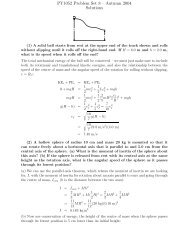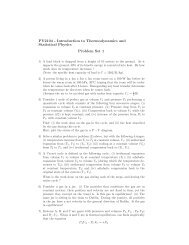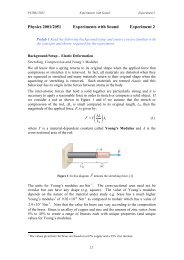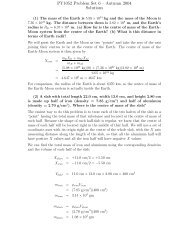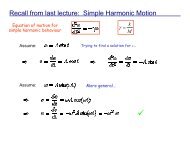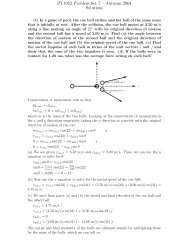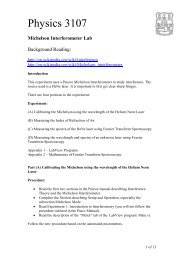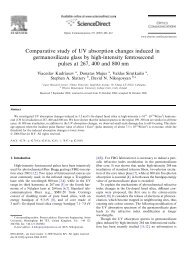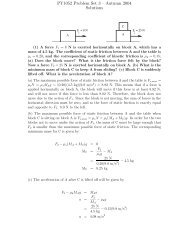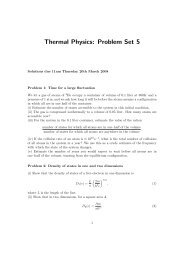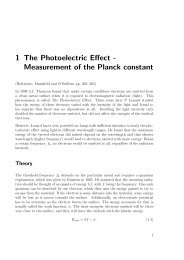optical characterisation of rare-earth doped fluoride and phosphate ...
optical characterisation of rare-earth doped fluoride and phosphate ...
optical characterisation of rare-earth doped fluoride and phosphate ...
- No tags were found...
Create successful ePaper yourself
Turn your PDF publications into a flip-book with our unique Google optimized e-Paper software.
10where j l (h (1)l) are spherical Bessel functions (Hankel functions <strong>of</strong> the rst kind) <strong>of</strong>order l <strong>and</strong> ! X lm = [l(l +1)]1=2 ! L Y lm <strong>and</strong> Y lm are vector spherical harmonic functionswith ! L = ! r ¢( ir). These functions (X lm <strong>and</strong> Y lm ) describe the sinusoidal nature<strong>of</strong> the eld corresponding to reections <strong>of</strong> the ray o the sphere surface.The three mode numbers, n, l, <strong>and</strong> m, are used to characterise the radial, theequatorial, <strong>and</strong> the polar components <strong>of</strong> the electromagnetic eld.Mode numbern (n = 1; 2; 3; : : :) gives the number <strong>of</strong> maxima in the radial electromagnetic elddistribution. The fundamental (n = 1) TM radial mode is depicted in Fig. 1.2(a)<strong>and</strong> two radial modes are depicted in Fig. 1.2(b). The second mode number, m(m = l; l + 1; : : : ; 0; : : : ; l 1; l), describes the number <strong>of</strong> maxima in the sinusoidalvariation in eld intensity in the equatorial or latitudinal direction.Finally, themode number l describes the eld intensity distribution in the polar or longitudinaldirection, <strong>and</strong> can take values l = 0; 1; 2; : : : with the number <strong>of</strong> maxima present inthe polar eld distribution given by l jmj + 1.For a perfect sphere (zero ellipticity), modes with the same l but dierent m valueshave a 2l + 1 degeneracy, <strong>and</strong>, therefore, the mode numbers n <strong>and</strong> l are sucient todescribe the WGM. In reality, some ellipticity exists in the sphere <strong>and</strong> this removesthe degeneracy. For minimal mode volumes one wants n to be small <strong>and</strong> m l,as shown in Fig. 1.3. The spheres used in the present studies have a diameter inthe range 50 - 200 m with < 5% ellipticity.Figure 1.3 shows a cross-section <strong>of</strong>the eld for dierent values <strong>of</strong> m <strong>and</strong> l. We see that the mode volume is lowest forthe fundamental mode <strong>and</strong> increases for more complicated mode structures. In theray optics picture, the fundamental mode represents a ray with the smallest reectionangle, the lowest diraction losses, the lowest mode volume, <strong>and</strong> the highest Q factor.




